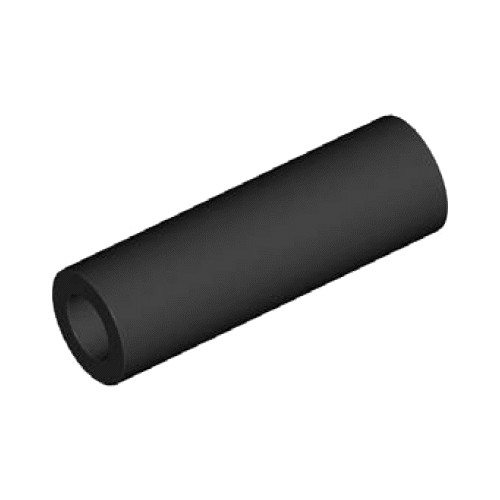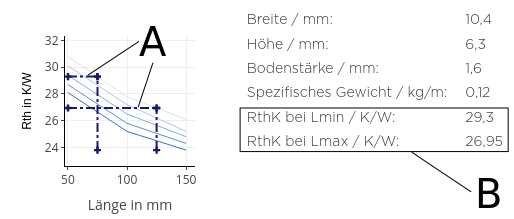
| Material | Polystyrole | |
| Length [mm]: | 35.0 | |
| Inner diameter [mm]: | 3.6 | |
| Outer diameter [mm]: | 7.0 | |
| Temperature resistance | 70.0 |
For the search results you get, based on the thermal power values, the expected thermal resistance for the minimum and maximum length entered:
A In the graphic by dashed lines
B As numerical values for the product data

Of course, you can also enter only a minimum or only a maximum length or leave the fields completely blank.
| ⚠ | Please note: We can mechanically process and anodise heat sinks up to a length of 1,700 mm. even if our thermal performance values are not stored up to this length. Please contact us if you require longer profiles. |
This input field allows you to search for heat sinks that do not exceed the entered maximum thermal resistance. exceed.
The stored thermal power values are searched and only those heatsinks are output which have a thermal resistance below the entered value. The recommended length is the length at which the heat sink reaches the entered value.
The thermal power values are stored for different power losses. If you leave the input field for power loss is left empty, the smallest power loss is assumed in the respective maps. If you enter a power loss is interpolated accordingly.
A For the heatsinks found, green markings or green rectangles indicate the permissible lengths.
B The recommended length is listed as a value in the product data.

You can also combine the search for the maximum thermal resistance with other filters (such as length). You will then only see the heatsinks that meet all the search criteria.

The search results can be sorted by piece weight. The unit weight is calculated for your individual search settings for each heatsink from the recommended length and the specific weight. The heatsink with the smallest unit weight is at the same time the heatsink with the least amount of material for your cooling task.
The following video explains the technical basics of our cooling solutions.
The equivalent circuit diagram outlines the thermal behavior of the arrangement.

| ϑJ Rth,J-C | The source on the left side represents the junction temperature ϑJ in the semiconductor. The power dissipation is dissipated via the thermal junction between the junction and the semiconductor package (Rth,J-C). This thermal resistance can usually be found in the data sheet of the used semiconductor used. |
| Rth,C-K ϑK | The contacting of the semiconductor package on the heat sink is modeled by the thermal resistance Rth,C-K. The heat sink temperature can be estimated via ϑK. |
| Rth,K | The thermal resistance of the heat sink indicates how well the power loss can be dissipated to the environment. The smaller the value, the lower the heat sink temperature at constant power dissipation. Or the smaller the value, the more power loss can be dissipated at constant ambient and heat sink temperature. |
By changing the parameters via the sliders, the values in the input fields of the search function are directly adapted and suitable products can be found.


| Material | Polystyrole | |
| Length [mm]: | 35.0 | |
| Inner diameter [mm]: | 3.6 | |
| Outer diameter [mm]: | 7.0 | |
| Temperature resistance | 70.0 |
| # | Length [mm] | Inner diameter [mm] | Outer diameter [mm] | |
|---|---|---|---|---|
| DI 617/1 | 1.0 | 3.2 | 6.0 | |
| DI 618/3 | 3.0 | 4.3 | 8.0 | |
| DI 617/3 | 3.0 | 3.2 | 6.0 | |
| DI 617/3,5 | 3.5 | 3.2 | 6.0 | |
| DI 610/4 | 4.0 | 4.2 | 8.0 | |
| DI 617/4 | 4.0 | 3.2 | 6.0 | |
| DI 618/4 | 4.0 | 4.3 | 8.0 | |
| DI 618/5 | 5.0 | 4.3 | 8.0 | |
| DI 610/5 | 5.0 | 4.5 | 8.0 | |
| DI 600/5 | 5.0 | 3.6 | 7.0 | |
| DI 618/6 | 6.0 | 4.3 | 8.0 | |
| DI 600/6 | 6.0 | 3.6 | 7.0 | |
| DI 617/6 | 6.0 | 3.2 | 6.0 | |
| DI 610/6 | 6.0 | 4.2 | 8.0 | |
| DI 600/7 | 7.0 | 3.6 | 7.0 | |
| DI 617/7 | 7.0 | 3.2 | 6.0 | |
| DI 618/7 | 7.0 | 4.3 | 8.0 | |
| DI 618/8 | 8.0 | 4.3 | 8.0 | |
| DI 600/8 | 8.0 | 3.6 | 7.0 | |
| DI 610/8 | 8.0 | 4.2 | 8.0 | |
| DI 617/8 | 8.0 | 3.2 | 6.0 | |
| DI 600/8,5 | 8.5 | 3.6 | 7.0 | |
| DI 600/9 | 9.0 | 3.6 | 7.0 | |
| DI 617/9 | 9.0 | 3.2 | 6.0 | |
| DI 617/10 | 10.0 | 3.2 | 6.0 | |
| DI 610/10 | 10.0 | 4.5 | 8.0 | |
| DI 617/11 | 11.0 | 3.2 | 6.0 | |
| DI 617/12 | 12.0 | 3.2 | 6.0 | |
| DI 618/12 | 12.0 | 4.3 | 8.0 | |
| DI 617/15 | 15.0 | 3.2 | 6.0 | |
| DI 618/15 | 15.0 | 4.3 | 8.0 | |
| DI 618/16 | 16.0 | 4.3 | 8.0 | |
| DI 610/18 | 18.0 | 4.2 | 8.0 | |
| DI 610/20 | 20.0 | 4.5 | 8.0 | |
| DI 618/20 | 20.0 | 4.3 | 8.0 | |
| DI 610/25 | 25.0 | 4.2 | 8.0 | |
| DI 610/27 | 27.0 | 4.2 | 8.0 | |
| DI 617/30 | 30.0 | 3.2 | 6.0 | |
| DI 610/30 | 30.0 | 4.2 | 8.0 | |
| DI 600/30 | 30.0 | 3.6 | 7.0 | |
| DI 600/35 | 35.0 | 3.6 | 7.0 |
